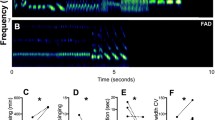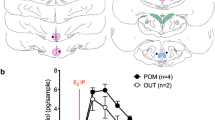Abstract
Oestradiol-17β (E2) formed from testosterone in the brain is thought to be involved in the hormonal control of male sexual behaviour in some mammal species1–3;. In the male dove, Streptopelia risoria, the aromatase system in the preoptic area (POA) is very active in converting testosterone to E2 (ref. 4), This oestrogenic metabolite has specific effects on male nest-orientated courtship patterns, which are mediated by an oestrogen-sensitive system in the preoptic-anterior hypothalamic area of the brain5. The preoptic aromatase system is likely to be important in the regulation of androgen action on male courtship behaviour, as no circulating oestrogen can be detected in the blood plasma of the male6. We report here that the level of aromatase activity in the POA depends on androgenic stimulation. Conversion of testosterone to E2 is markedly increased in castrated males injected intramuscularly (i.m.) with testosterone propionate (TP). Increased aromatase activity seems to be due to induction of the enzyme and is specific to the POA These findings indicate that the formation of behaviourally effective oestrogen in a specific brain target area is under hormonal control and suggest a role for this regulatory mechanism in the integration of courtship behaviour in the male dove.
Similar content being viewed by others
References
McEwen, B. S., Davis, P. G., Parsons, B. & Pfaff, D. W. A. Rev. Neurosci. 2, 65–112 (1979).
Naftolin, F. & Ryan, K. J. J. Steroid Biochem. 6, 993–997 (1975).
Perez-Palacios, G., Larsson, K. & Beyer, C. J. Steroid Biochem. 6, 999–1006 (1975).
Steimer, Th. & Hutchison, J. B. Brain Res. 192, 586–591 (1980).
Hutchison, J. B. J. Reprod. Fert. 11, 15–41 (1970).
Korenbrot, C. C., Schomberg, D. W. & Erickson, C. J. Endocrinology 94, 1126–1132 (1974).
Hutchison, J. B. J. Endocr. 50, 97–113 (1971).
Hutchison, J. B., Steimer, Th. & Duncan, R. J. Endocr. (in the press).
Martinez-Vargas, M. C., Stumpf, W. E. & Sar, M. J. comp. Neurol. 167, 83–104 (1976).
Reddy, V. R., Naftolin, F. & Ryan, K. J. Endocrinology 92, 589–594 (1973).
Callard, G. V. Brain Res. 204, 461–464 (1981).
Bellino, F. I., Hussa, R. O. & Osawa, Y. Steroids 32, 37–44 (1978).
Armstrong, D. T. & Dorrington, J. H. in Regulatory Mechanisms Affecting Gonadal Hormone Action (eds Thomas, J. A. & Singhal, R. L.) 217–258 (HM & M, Aylesbury, (1977).
Verhoeven, G., Dierickx, P. & De Moor, P. Molec. cell Endocr. 13, 241–253 (1979).
Hutchison, J. B. in Advances in the Study of Behaviour (eds Rosenblatt, J. F., Hinde, R. A., Shaw, F. & Beer, C.) 159–200 (Academic, New York, 1976).
Feder, H. H., Storey, A., Goodwind, D., Reboulleau, C. & Silver, R. Biol. Reprod. 16, 666–677 (1977).
Hutchison, J. B. & Steimer, Th. Science (in the press).
Steimer, Th. & Hutchison, J. B. Brain Res. 209, 189–204 (1981).
Author information
Authors and Affiliations
Rights and permissions
About this article
Cite this article
Steimer, T., Hutchison, J. Androgen increases formation of behaviourally effective oestrogen in dove brain. Nature 292, 345–347 (1981). https://doi.org/10.1038/292345a0
Received:
Accepted:
Issue Date:
DOI: https://doi.org/10.1038/292345a0
- Springer Nature Limited
This article is cited by
-
On the role of brain aromatase in females: why are estrogens produced locally when they are available systemically?
Journal of Comparative Physiology A (2018)
-
Peripheral auditory processing changes seasonally in Gambel’s white-crowned sparrow
Journal of Comparative Physiology A (2010)
-
A direct androgenic involvement in the expression of human corticotropin-releasing hormone
Molecular Psychiatry (2006)
-
Aromatase inhibition abolishes courtship behaviours in the ring dove (Streptopelia risoria) and reduces androgen and progesterone receptors in the hypothalamus and anterior pituitary gland
Molecular and Cellular Biochemistry (2005)
-
Aromatase-immunoreactive cells are present in mouse brain areas that are known to express high levels of aromatase activity
Cell and Tissue Research (1995)





